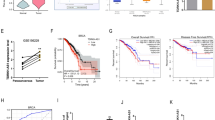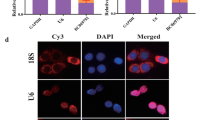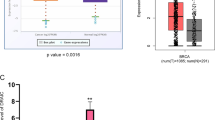Abstract
Possible roles of long noncoding RNAs (lncRNAs) in cancer stem cells (CSCs) have often been reported. Here, we focused on the regulatory function of the lncRNA Down syndrome critical region 9 (DSCR9) in breast cancer stem cells (BCSCs). Through bioinformatics analysis, DSCR9, microRNA-504-5p (miR-504-5p), and G protein-coupled receptor 65 (GPR65) were identified as targets implicated in breast cancer development. Then, clinical tissue samples, breast cancer cells, and isolated BCSCs were used to determine the expression of DSCR9, miR-504-5p, and GPR65. The results confirmed the overexpression of DSCR9 and GPR65 but low expression of miR-504-5p in breast cancer tissues and cells as well as in BCSCs. Following mechanistic investigation, it was found that DSCR9 targeted miR-504-5p, and that silencing DSCR9 inhibited the proliferation of BCSCs by elevating the expression of miR-504-5p. Additionally, miR-504-5p targeted GPR65 and inhibited its expression. Moreover, GPR65 activated the MEK/ERK signaling pathway to regulate BCSC proliferation. Finally, animal study verified that depletion of DSCR9 inhibited the proliferation of BCSCs in vivo and that BCSC proliferation was restored by overexpression of GPR65. Altogether, our findings revealed that DSCR9 elevated GPR65 expression by targeting miR-504-5p to exacerbate breast cancer, highlighting a new treatment modality for breast cancer.








Similar content being viewed by others
Data availability
The data that supports the findings of this study are available on request from the corresponding author.
Abbreviations
- BCSCs:
-
Breast cancer stem cells
- cDNA:
-
Complementary DNA
- DSCR9:
-
Down syndrome critical region gene 9
- GAPDH:
-
Glyceraldehyde-3-phosphate dehydrogenase
- GEO:
-
Gene expression omnibus
- GPR65:
-
G protein-coupled receptor 65
- IHC:
-
Immunohistochemistry
- lncRNAs:
-
Long non-coding RNAs
- MEK/ERK:
-
Mitogen-activated protein kinase kinase/extracellular regulated protein kinase
- miR:
-
MicroRNA
- mRNAs:
-
Messenger RNAs
- shRNA:
-
Short hairpin RNA
- MEK/ERK signaling pathway:
-
Mitogen-activated protein kinase kinase/extracellular regulated protein kinase signaling pathway
- RPMI:
-
Roswell park memorial institute
- ALDH-1:
-
Aldehyde dehydrogenase-1
- NC:
-
Negative control
- RT-qPCR:
-
Reverse transcription quantitative polymerase chain reaction
- FISH:
-
Fluorescence in situ hybridization
- HRP:
-
Horseradish peroxidase
- IgG:
-
Immunoglobulin G
- DMSO:
-
Dimethylsulfoxide
- CCK-8:
-
Cell counting kit-8
- WT:
-
Wild type
- MUT:
-
Mutant type
- RIP:
-
RNA binding protein immunoprecipitation
- AGO2:
-
Argonaute2
- ANOVA:
-
Analysis of variance
References
Wang X, Wang C, Guan J, et al. Progress of breast cancer basic research in China. Int J Biol Sci. 2021;17:2069–79. https://doi.org/10.7150/ijbs.60631.
Youn HJ, Han W. A review of the epidemiology of breast cancer in asia: focus on risk factors. Asian Pac J Cancer Prev. 2020;21:867–80. https://doi.org/10.31557/APJCP.2020.21.4.867.
Trayes KP, Cokenakes SEH. Breast cancer treatment. Am Fam Physician. 2021;104:171–8.
Lei S, Zheng R, Zhang S, et al. Global patterns of breast cancer incidence and mortality: a population-based cancer registry data analysis from 2000 to 2020. Cancer Commun (Lond). 2021;41:1183–94. https://doi.org/10.1002/cac2.12207.
Butti R, Gunasekaran VP, Kumar TVS, Banerjee P, Kundu GC. Breast cancer stem cells: biology and therapeutic implications. Int J Biochem Cell Biol. 2019;107:38–52. https://doi.org/10.1016/j.biocel.2018.12.001.
Shen Y, Peng X, Shen C. Identification and validation of immune-related lncRNA prognostic signature for breast cancer. Genomics. 2020;112:2640–6. https://doi.org/10.1016/j.ygeno.2020.02.015.
Li X, Jin F, Li Y. A novel autophagy-related lncRNA prognostic risk model for breast cancer. J Cell Mol Med. 2021;25:4–14. https://doi.org/10.1111/jcmm.15980.
Liu Z, Mi M, Li X, et al. A lncRNA prognostic signature associated with immune infiltration and tumour mutation burden in breast cancer. J Cell Mol Med. 2020;24:12444–56. https://doi.org/10.1111/jcmm.15762.
Lin C, Yang L. Long noncoding RNA in cancer: wiring signaling circuitry. Trends Cell Biol. 2018;28:287–301. https://doi.org/10.1016/j.tcb.2017.11.008.
Fan CN, Ma L, Liu N. Systematic analysis of lncRNA-miRNA-mRNA competing endogenous RNA network identifies four-lncRNA signature as a prognostic biomarker for breast cancer. J Transl Med. 2018;16:264. https://doi.org/10.1186/s12967-018-1640-2.
Liu Y, Li M, Yu H, Piao H. lncRNA CYTOR promotes tamoxifen resistance in breast cancer cells via sponging miR125a5p. Int J Mol Med. 2020;45:497–509. https://doi.org/10.3892/ijmm.2019.4428.
Zheng A, Song X, Zhang L, et al. Long non-coding RNA LUCAT1/miR-5582-3p/TCF7L2 axis regulates breast cancer stemness via Wnt/beta-catenin pathway. J Exp Clin Cancer Res. 2019;38:305. https://doi.org/10.1186/s13046-019-1315-8.
Chen M, Wang J, Luo Y, et al. Identify Down syndrome transcriptome associations using integrative analysis of microarray database and correlation-interaction network. Hum Genomics. 2018;12:2. https://doi.org/10.1186/s40246-018-0133-y.
Chen X, Lv C, Zhu X, Lin W, Wang L, Huang Z, et al. MicroRNA-504 modulates osteosarcoma cell chemoresistance to cisplatin by targeting p53. Oncol Lett. 2019;17(2):1664–74. https://doi.org/10.3892/ol.2018.9749.
Quan H, Li B, Yang J. MicroRNA-504 functions as a tumor suppressor in hepatocellular carcinoma through inhibiting Frizzled-7-mediated-Wnt/beta-catenin signaling. Biomed Pharmacother. 2018;107:754–62. https://doi.org/10.1016/j.biopha.2018.07.150.
Ford NA, Dunlap SM, Wheatley KE, Hursting SD. Obesity, independent of p53 gene dosage, promotes mammary tumor progression and upregulates the p53 regulator microRNA-504. PLoS One. 2013;8:e68089. https://doi.org/10.1371/journal.pone.0068089.
Bai Y, Li C, Xia L, et al. Identifies immune feature genes for prediction of chemotherapy benefit in cancer. J Cancer. 2022;13:496–507. https://doi.org/10.7150/jca.65646.
Ryder C, McColl K, Zhong F, Distelhorst CW. Acidosis promotes Bcl-2 family-mediated evasion of apoptosis: involvement of acid-sensing G protein-coupled receptor Gpr65 signaling to Mek/Erk. J Biol Chem. 2012;287:27863–75. https://doi.org/10.1074/jbc.M112.384685.
Qin WY, Feng SC, Sun YQ, Jiang GQ. MiR-96–5p promotes breast cancer migration by activating MEK/ERK signaling. J Gene Med. 2020;22:e3188. https://doi.org/10.1002/jgm.3188.
Zhu X, Li Y, Xu G, Fu C. Growth hormone receptor promotes breast cancer progression via the BRAF/MEK/ERK signaling pathway. FEBS Open Bio. 2020;10:1013–20. https://doi.org/10.1002/2211-5463.12816.
Li J, Su W, Zhang S, et al. Epidermal growth factor receptor and AKT1 gene copy numbers by multi-gene fluorescence in situ hybridization impact on prognosis in breast cancer. Cancer Sci. 2015;106:642–9. https://doi.org/10.1111/cas.12637.
Zhang QS, Zhang M, Huang XJ, Liu XJ, Li WP. Downregulation of SENP1 inhibits cell proliferation, migration and promotes apoptosis in human glioma cells. Oncol Lett. 2016;12:217–21. https://doi.org/10.3892/ol.2016.4558.
Huang L, Li X, Ye H, et al. Long non-coding RNA NCK1-AS1 promotes the tumorigenesis of glioma through sponging microRNA-138-2-3p and activating the TRIM24/Wnt/beta-catenin axis. J Exp Clin Cancer Res. 2020;39:63. https://doi.org/10.1186/s13046-020-01567-1.
Liu S, Sun Y, Hou Y, et al. A novel lncRNA ROPM-mediated lipid metabolism governs breast cancer stem cell properties. J Hematol Oncol. 2021;14:178. https://doi.org/10.1186/s13045-021-01194-z.
Lucero M, Thind J, Sandoval J, et al. Stem-like cells from invasive breast carcinoma cell line MDA-MB-231 express a distinct set of Eph receptors and Ephrin ligands. Cancer Genomics Proteomics. 2020;17:729–38. https://doi.org/10.21873/cgp.20227.
Xie J, Xiao Y, Zhu XY, et al. Hypoxia regulates stemness of breast cancer MDA-MB-231 cells. Med Oncol. 2016;33:42. https://doi.org/10.1007/s12032-016-0755-7.
Hiraga T, Ito S, Nakamura H. Side population in MDA-MB-231 human breast cancer cells exhibits cancer stem cell-like properties without higher bone-metastatic potential. Oncol Rep. 2011;25:289–96.
Reiners JJ Jr, Lee JY, Clift RE, Dudley DT, Myrand SP. PD98059 is an equipotent antagonist of the aryl hydrocarbon receptor and inhibitor of mitogen-activated protein kinase kinase. Mol Pharmacol. 1998;53:438–45. https://doi.org/10.1124/mol.53.3.438.
Zelivianski S, Spellman M, Kellerman M, et al. ERK inhibitor PD98059 enhances docetaxel-induced apoptosis of androgen-independent human prostate cancer cells. Int J Cancer. 2003;107:478–85. https://doi.org/10.1002/ijc.11413.
Fahad UM. Breast cancer: current perspectives on the disease status. Adv Exp Med Biol. 2019;1152:51–64. https://doi.org/10.1007/978-3-030-20301-6_4.
Dittmer J. Breast cancer stem cells: features, key drivers and treatment options. Semin Cancer Biol. 2018;53:59–74. https://doi.org/10.1016/j.semcancer.2018.07.007.
Yegnasubramanian S, Wu Z, Haffner MC, et al. Chromosome-wide mapping of DNA methylation patterns in normal and malignant prostate cells reveals pervasive methylation of gene-associated and conserved intergenic sequences. BMC Genomics. 2011;12:313. https://doi.org/10.1186/1471-2164-12-313.
Zhang SL, Du X, Tan LN, et al. SET7 interacts with HDAC6 and suppresses the development of colon cancer through inactivation of HDAC6. Am J Transl Res. 2020;12:602–11.
Zhuang H, Huang S, Zhou Z, et al. A four prognosis-associated lncRNAs (PALnc) based risk score system reflects immune cell infiltration and predicts patient survival in pancreatic cancer. Cancer Cell Int. 2020;20:493. https://doi.org/10.1186/s12935-020-01588-y.
Liu Z, Mi M, Li X, et al. lncRNA OSTN-AS1 may represent a novel immune-related prognostic marker for triple-negative breast cancer based on integrated analysis of a ceRNA network. Front Genet. 2019;10:850. https://doi.org/10.3389/fgene.2019.00850.
Ge A, Liu L, Deng X, Luo J, Xu Y. Exploring the mechanism of baicalin intervention in breast cancer based on MicroRNA microarrays and bioinformatics strategies. Evid Based Complement Alternat Med. 2021;2021:7624415. https://doi.org/10.1155/2021/7624415.
Kikkawa N, Kinoshita T, Nohata N, et al. microRNA-504 inhibits cancer cell proliferation via targeting CDK6 in hypopharyngeal squamous cell carcinoma. Int J Oncol. 2014;44:2085–92. https://doi.org/10.3892/ijo.2014.2349.
Bier A, Hong X, Cazacu S, et al. miR-504 modulates the stemness and mesenchymal transition of glioma stem cells and their interaction with microglia via delivery by extracellular vesicles. Cell Death Dis. 2020;11:899. https://doi.org/10.1038/s41419-020-03088-3.
Gao W, Wang F, Lu Y, et al. MiR-504 promotes cell proliferation and metastasis by targeting BRMS1 in breast cancer. Panminerva Med. 2022;64:415–6. https://doi.org/10.23736/S0031-0808.19.03740-6.
Lu G, Li Y, Ma Y, et al. Long noncoding RNA LINC00511 contributes to breast cancer tumourigenesis and stemness by inducing the miR-185-3p/E2F1/Nanog axis. J Exp Clin Cancer Res. 2018;37:289. https://doi.org/10.1186/s13046-018-0945-6.
Song X, Zhang X, Wang X, et al. LncRNA SPRY4-IT1 regulates breast cancer cell stemness through competitively binding miR-6882-3p with TCF7L2. J Cell Mol Med. 2020;24:772–84. https://doi.org/10.1111/jcmm.14786.
Li Y, Wu C. LINC00261/microRNA-550a-3p/SDPR axis affects the biological characteristics of breast cancer stem cells. IUBMB Life. 2021;73:188–201. https://doi.org/10.1002/iub.2416.
Wang HX, Chen YH, Zhou JX, et al. Overexpression of G-protein-coupled receptors 65 in glioblastoma predicts poor patient prognosis. Clin Neurol Neurosurg. 2018;164:132–7. https://doi.org/10.1016/j.clineuro.2017.11.017.
Klatt W, Wallner S, Brochhausen C, Stolwijk JA, Schreml S. Expression profiles of proton-sensing G-protein coupled receptors in common skin tumors. Sci Rep. 2020;10:15327. https://doi.org/10.1038/s41598-020-71700-9.
Ihara Y, Kihara Y, Hamano F, et al. The G protein-coupled receptor T-cell death-associated gene 8 (TDAG8) facilitates tumor development by serving as an extracellular pH sensor. Proc Natl Acad Sci U S A. 2010;107:17309–14. https://doi.org/10.1073/pnas.1001165107.
Kumar D, Patel SA, Hassan MK, et al. Reduced IQGAP2 expression promotes EMT and inhibits apoptosis by modulating the MEK-ERK and p38 signaling in breast cancer irrespective of ER status. Cell Death Dis. 2021;12:389. https://doi.org/10.1038/s41419-021-03673-0.
Dandawate PR, Subramaniam D, Jensen RA, Anant S. Targeting cancer stem cells and signaling pathways by phytochemicals: Novel approach for breast cancer therapy. Semin Cancer Biol. 2016;40–41:192–208. https://doi.org/10.1016/j.semcancer.2016.09.001.
Funding
This study was supported by Quanzhou Science and Technology Bureau of Fujian Province (No. 2019N038S).
Author information
Authors and Affiliations
Contributions
ML: wrote the paper and conceived and designed the experiments; analyzed the data; collected and provided the sample for this study. CL: wrote the paper and conceived and designed the experiments; analyzed the data. ZC: wrote the paper and conceived and designed the experiments; collected and provided the sample for this study.
Corresponding author
Ethics declarations
Conflict of interest
The authors declare that they have no competing interests.
Ethics approval
All research protocols were approved by the Clinical Research Ethics Committee of Quanzhou First Hospital Affiliated Fujian Medical University (FJYKDXFSQZDYYY-CE-2016-0127) and in line with the Declaration of Helsinki. All patients signed informed consent forms prior to the experiments. Additionally, The animal experiments were approved by Quanzhou First Hospital Affiliated Fujian Medical University (FJYKDXFSQZDYYY-AE-2018-0506) and strictly designed and performed conforming to the Guide for the Care and Use of Laboratory Animal by the US National Institutes of Health. All efforts were made for minimizing the number and suffering of the included animals.
Consent for publication
Consent for publication was obtained from the participants.
Additional information
Publisher's Note
Springer Nature remains neutral with regard to jurisdictional claims in published maps and institutional affiliations.
Supplementary Information
Below is the link to the electronic supplementary material.
13577_2023_916_MOESM1_ESM.eps
Supplementary file1 Fig. S1 Relationship between DSCR9 and clinicopathologic features of breast cancer patients and overall survival analysis in breast cancer subgroup. A, The relationship between DSCR9 and clinicopathological features of breast cancer patients was analyzed based on the BC-GenExMiner database. B, Overall survival of DSCR9 in breast cancer subgroup was analyzed based on the BC-GenExMiner database. (EPS 2237 KB)
Rights and permissions
Springer Nature or its licensor (e.g. a society or other partner) holds exclusive rights to this article under a publishing agreement with the author(s) or other rightsholder(s); author self-archiving of the accepted manuscript version of this article is solely governed by the terms of such publishing agreement and applicable law.
About this article
Cite this article
Li, M., Lin, C. & Cai, Z. Downregulation of the long noncoding RNA DSCR9 (Down syndrome critical region 9) delays breast cancer progression by modulating microRNA-504-5p-dependent G protein-coupled receptor 65. Human Cell 36, 1516–1534 (2023). https://doi.org/10.1007/s13577-023-00916-4
Received:
Accepted:
Published:
Issue Date:
DOI: https://doi.org/10.1007/s13577-023-00916-4




